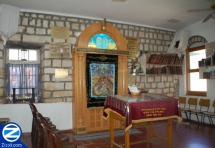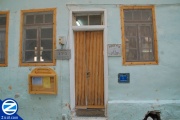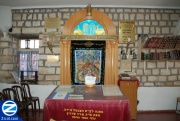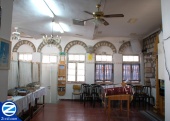Beirav Synagogue Safed
The Beirav Synagogue is a popular Shul located in the Old City of Tzfat. It is named after Rebbe Yaakov Beirav, a 16th century Tzfat rabbi. Currently the Beirav Shul is run by followers of Shlomo Carlebach, who conduct prayer services based on songs that he composed. Each Shabbos the Synagogue is crowded with tourists who want to experience the Carlebach singing minyon.
Contents |
[edit] Rabbi Ya’akov Beirav
The Beirav synagogue was named after Rabbi Ya’akov Beirav, a major figure in Tzfat’s history as well as in the history of 16th century Judaism. Rabbi Beirav was already a recognized scholar when he arrived in Tzfat in the early 1500s. He accepted the post as Tzfat’s Chief Rabbi and presided at a time when some of the greatest Jewish sages and rabbis were coming to live and study in Tzfat.Rabbi Beirav believed that the time was ripe to reintroduce the Sanhedrin, the ancient Rabbinical Assembly which had ruled the Jewish people in Israel during the times of the Temple. Many small towns had their own local Sanhedrin while the Grand Sanhedrin, in Jerusalem, held final authority over civil and religious matters. The Romans disbanded the Sanhedrin in the 4th century A.D. but Rabbi Beirav believed that the Jewish world was ready to reinstitute the body. He advocated the reestablishment of the Sandhedrin as a central body which could help guide Jews through the upheavals of the Inquisition and Spanish exile and reunite the scattered Jewish communities under a common leadership.
Toward this end Rabbi Beirav accepted “Smicha” -- ordination -- from an assembly of 25 Tzfat rabbis. He then proceeded to grant smicha to Tzfat rabbinical giants such as Rabbi Moshe Cordevero, Rabbi Moshe d'Trani, Rabbi Moshe Alsheich, Rabbi Yosef Caro and, the Chief Rabbi of Jerusalem, Rabbi Levi Chaviv.Rabbi Chaviv objected strenuously. His insinuations, that Rabbi Beirav was preparing for a Jewish nationalist return to Israel, reached the ears of the Turkish rulers and Rabbi Beirav was forced to flee Tzfat.
The chain of new ordinations ended within two generations, but many of Rabbi Beirav’s objectives, including welcoming back Jews who had converted to Christianity forcibly under the Inquisition, were accepted by the rabbinical authorities of the day. The theme of unity is echoed in the prayer services that take place in today’s Beirav synagogue.
[edit] Shlomo Carlebach
Rabbi Carlebach was an outreach rabbi who traveled throughout the world during the latter half of the 20th century. His goal was to bring disaffected Jews closer to their heritage through songs and stories. He believed that touching a person’s heart in this way offered the best possibility to encourage them to explore their Jewish “neshama” -- their soul. During his lifetime Rabbi Carlebach composed hundreds of melodies and tunes for traditional prayers and his followers have created “Carlebach Minyans” -- communities -- throughout the world which incorporate these songs.[edit] Fighting Assimilation
Shlomo Carlebach's travels and outreach work began in the 1950s, at a time when the majority of the Jewish world was not aware of the dangers of assimilation that awaited the Jewish community. Shlomo told Hassidic stories and drew people to Jewish life through the Jewish music that he composed and played.
[edit] Philosophy of Acceptance
Shlomo taught acceptance of each person at their own level. Many individuals grew in Jewish observance and communal affiliation as a result of their encounters with Shlomo because Shlomo taught through example and stories.
[edit] Proliferation of Carlebach Synagogues
Although Shlomo died in 1996, “Carlebach synagogues” and Carlebach prayer groups have grown throughout the world. These “Carlebach Minyans” are led by Shlomo’s followers who create their synagogues in the Carlebach style. In Tzfat, Beirav community members incorporate his melodies in the Beirav prayer service.
[edit] Beirav Services
The Beirav Synagogue is located on HaMeginim Street in the northeastern quarter of Tzfat’s Old City. This shul was built in the 19th century in the “Ashkanazi” Quarter, the residential area of the 18th and 19th century Eastern European immigrants. The building originally served as a “yeshiva” -- a religious academy -- and was named “Beirav.” Residents, including the local Hungarian community and, later, Holocaust survivors, began to use it as a synagogue who referred to it as the “Mizrachi” synagogue.
[edit] Beirav's Modern History
The existing minyan of elderly Tzfat men and Hungarian Holocaust survivors disbanded in the 1970s but was revitalized in the 1990s by a group of local English-speaking residents who included the prayer style of Rabbi Shlomo Carlebach in the services.
[edit] Services at Beirav
Today visitors arrive from throughout the world to visit the Beirav Synagogue and join the services on the Sabbath and holidays. Morning Shaharit services which include musical Hallel prayers take place in the synagogue on Yom HaAtzmaut -- Independence Day, “Rosh Chodesh” -- the first day of the Jewish month -- and during Hanukah. The Friday night “Kabbalah Shabbat” -- Welcoming the Sabbath -- services at Beirav spill out onto the street with spirited dancing and singing. Some people come to Beirav for the Saturday night musical Havdallah -- Sabbath end -- ceremony which includes guitars and other musical instruments.
[edit] Orthodox Prayer Style
The Beirav Synagogue follows the Orthodox prayer style. Men and women sit separately although, as opposed to most Orthodox shuls, women are encouraged to sing and, if they wish, to dance.
[edit] House of Love and Prayer
In recent years the Carlebach group split up and a new second minyon called the House of Love and Prayer was established.
| |||||||||||
| |||||||||||||||||





